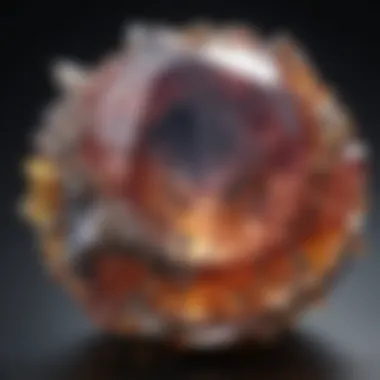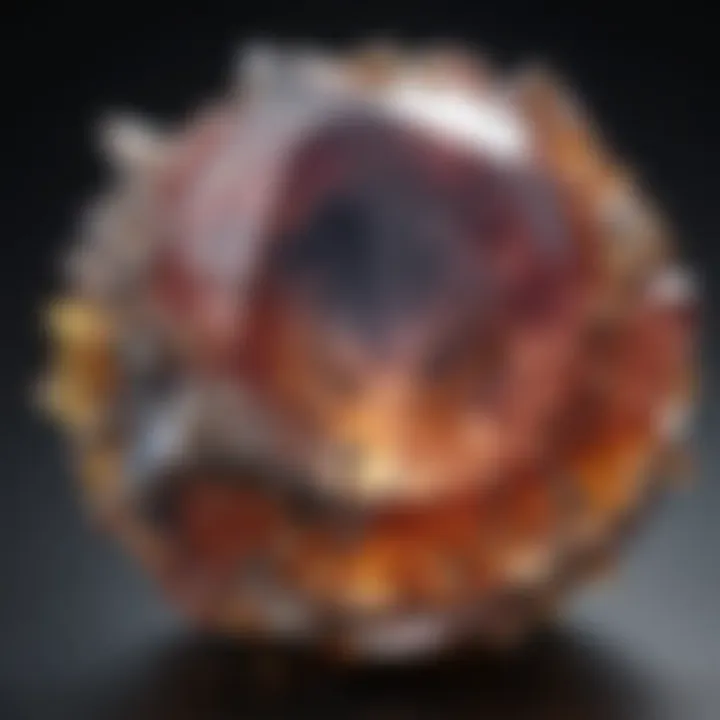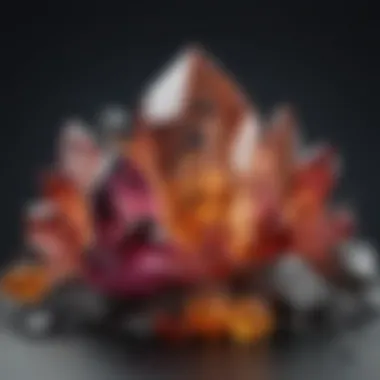Mastering Gemstone Identification Techniques and Tools


Intro
Gemstones have fascinated humans for centuries, not merely for their dazzling aesthetics but also for the rich stories they hold within. This intrigue gives rise to the necessity of gemstone identification—a skill that enables enthusiasts, jewelers, and collectors to distinguish genuine gems from mere imitations. Whether you’re hoping to identify a rare sapphire or uncover the origins of an emerald, understanding how to recognize various gemstones is crucial. This guide seeks to illuminate the methodologies and resources essential for effective gemstone identification while exploring their properties, classification, and historical significance.
Gemstone Overview
Definition and characteristics
At the heart of gemstone identification lies a clear understanding of what defines a gemstone. Generally, gemstones are minerals or rocks that have been cut, polished, and crafted to be used in jewelry or ornamentation. Some popular examples include diamonds, rubies, and amethysts. Distinctive characteristics set each gemstone apart, which can range from color and luster to clarity and hardness. A gemstone's value often hinges on these traits, alongside its rarity.
Classification of gemstones
Gemstones can be classified into two broad categories: precious and semi-precious. Precious stones, such as diamonds, rubies, and sapphires, have long been regarded as the crown jewels of the gem world due to their durability and brilliance. Semi-precious stones, while equally captivating in their own right, such as turquoise or garnet, generally possess certain characteristics that make them less sought after in terms of market value.
Some common categories include:
- Mineral gemstones: Formed from natural minerals, such as quartz and garnet.
- Organic gemstones: Created from biological sources, including pearls and amber.
- Synthetic gemstones: Man-made but mimic natural stones in appearance and properties, like cubic zirconia.
Properties of Gemstones
Physical properties
The physical properties of gemstones are paramount in the identification process. Key characteristics include:
- Hardness: Measured on the Mohs scale, it informs about a gem's scratch resistance.
- Color: The hue, tone, and saturation give insights into its identity and quality.
- Clarity: Refers to the presence of inclusions or blemishes, affecting a stone’s brilliance.
- Luster: The way light interacts with a surface, which can range from glossy to dull.
Chemical properties
On the molecular level, each gemstone embodies unique chemical properties governing their formation and sustainability.
- Chemical composition: For instance, emeralds are beryl (Be 3 Al 2 Si 6 O 18) with chromium and vanadium giving them their distinct green color.
- Refractive index: This aspect determines how much a gemstone bends light, providing a crucial clue for identification.
In summary, gemstone identification is a nuanced art requiring awareness of various properties and classifications. By grasping these factors, enthusiasts and professionals alike can more confidently explore the enchanting world of gemstones.
Foreword to Gemstone Identification
Gemstone identification stands as a crucial aspect of gemology, serving not just as an academic exercise but as a practical necessity for various stakeholders in the industry. Whether you're a jewelry designer looking to source authentic materials, a collector interested in the fine nuances of gemstones, or simply an enthusiast eager to learn more, the ability to accurately identify gemstones holds immense significance. By focusing on precise identification, one minimizes the risk of acquiring imitations or synthetics, which can undermine the value and charm of the collection.
In the gem marketplace, misidentification can lead to substantial financial losses. Indeed, one may pay top dollar for what is, in reality, a glass bauble fashioned to look like an authentic sapphire. Consequently, the accurate identification of gemstones is not just a technical skill, but rather a cornerstone of trust in transactions. A meticulous approach allows buyers to invest confidently, knowing that their choices are supported by reliable data and evidence.
Additionally, correct identification lends insight into the gemstone's origin and geological history, enriching the narrative behind each piece. It transforms gemstones from mere decorative items into unique artifacts with stories to tell about Earth’s own processes over centuries.
Importance of Accurate Identification
The landscape of gemology is dotted with diverse varieties of gemstones, each with its unique properties. When identification is precise, it goes beyond mere aesthetics; it fosters appreciation and genuine understanding. A gemstone's refractive index, inclusions, and color zoning can offer clues to its authenticity and geographic origin. This knowledge is ultimately empowering for collectors and sellers alike.
Knowing these details can make all the difference in determining the worth and desirability of a gemstone. Similarly, skilled identification can help discern natural stones from their synthetic counterparts, a distinction that carries significant implications for value.
"The allure of gemstones is not merely in their beauty, but in the stories they hold about nature's wonders and time's artistry."
Furthermore, precise identification also aligns with ethical considerations. As consumers become more conscious, understanding a gem’s provenance is increasingly important. This consciousness affects market trends and purchasing decisions. Hence, becoming proficient in identification techniques can elevate one’s standing not just as a buyer or seller but also as an advocate for ethical practices.
Overview of Identification Techniques
To effectively navigate the world of gemstones, understanding the various identification techniques becomes essential. These methods range from simple visual examinations to advanced scientific testing.
- Physical Tests: The first level of identification often involves physical attributes, such as firmness, smoothness, and weight. Using a loupe, one can examine inclusions or surface imperfections.
- Optical Tests: Here, we consider methods like refractive index measurement or receiving insights from polarization filters which help distinguish between different gemstones.
- Chemical Testing: More advanced identification might involve using gemological instruments that analyze the chemical composition of a gemstone. Such tests can reveal elements that define a stone's classification.
Ultimately, a proper identification process may rely on a combination of these techniques, allowing gemologists to form a comprehensive picture of what they are examining. Employing these methods as part of an overarching strategy leads not only to accurate identification but also to informed decisions that resonate through the intricacies of the gemstone industry.
Types of Gemstones
In the realm of gemstone identification, distinguishing between types of gemstones provides a foundational understanding for enthusiasts and professionals alike. The categorization into precious and semi-precious gemstones offers not just a clear classification but also a gateway into the unique characteristics, historical significance, and valuation of each stone. Understanding these types not only helps in accurate identification but also cultivates appreciation for their rarity and inherent beauty.
Precious Gemstones
Precious gemstones have long captured human fascination, often associated with luxury, rarity, and specific cultural significance. Four stones reign supreme in this category: diamonds, rubies, sapphires, and emeralds. Each brings its own allure and distinct properties to the table.
- Diamonds are renowned for their unmatched hardness and brilliant sparkle. Beyond their physical characteristics, they hold cultural symbolism ranging from enduring love to power.
- Rubies are celebrated for their captivating red hues, stemming from chromium content. They symbolize passion but also bear historical ties to royalty and protection.
- Sapphires come in a kaleidoscope of colors, excluded only from vibrant reds, which categorize them as rubies. They are often associated with wisdom and nobility.
- Emeralds display lush green colors, rich in history and connection to fertility and rebirth.
The identification of precious gemstones requires a diligent eye. Their rarity and value demand an understanding of not only their physical properties but also their market trends. Investors must consider the stone's provenance and treatment history, as these factors significantly influence value.
Semi-Precious Gemstones
On the other side of the spectrum lie semi-precious gemstones. These stones, while often abundant compared to their precious counterparts, carry their own profound stories and significance. Noteworthy examples include amethyst, citrine, garnet, and turquoise.
- Amethyst, the vibrant purple variety of quartz, has long been associated with clarity of mind and calmness. It is affordable yet cherished by collectors for its deep hues and versatility in jewelry.
- Citrine, characterized by its cheerful yellow-orange radiance, is believed to carry the energy of the sun. It’s often favored for its affordability and bright aesthetic appeal.
- Garnets offer a rich spectrum of colors, commonly tied to themes of love and friendship.
- Turquoise, with its distinct blue-green colors, has deep cultural roots, especially among indigenous peoples of North America.
Understanding semi-precious gemstones is equally important, as they are widely used in various jewelry designs and often provide a more accessible entry point for budding collectors. Their commonality doesn’t belittle their charm; each holds unique stories that add layers of meaning.
As gemstone enthusiasts delve into the classification of these gem types, they unveil the layers of history, culture, and value that inform their allure. This understanding ensures that every gemstone, whether precious or semi-precious, is appreciated not only for its beauty but also for its journey from the earth to its current form and setting.


"Knowing the type of gemstone is the first step towards understanding its value and significance in our lives."
Physical Properties of Gemstones
Understanding the physical properties of gemstones lays the groundwork for accurate identification and valuation. Each gem possesses unique characteristics that bear significant influence not only on its aesthetic appeal but also on its durability and market value. Focusing on these attributes can empower enthusiasts—be it collectors, jewelers, or geologists—to differentiate between various stones with ease and precision.
The key physical properties often discussed include color, hardness, and clarity. Each property plays a crucial role— while color influences visual attraction, hardness relates directly to the gem's longevity, and clarity affects its overall brilliance and desirability. Clearly grasping these elements provides an essential toolkit for anyone working closely with gemstones.
Color Analysis
Color is arguably the most immediate and recognizable aspect of any gemstone. Every gemstone comes alive through its hue, saturation, and tone, providing not just beauty but also important clues about its identity. For instance, consider the stunning blue of a sapphire compared to the rich green of an emerald. These color variations stem from unique elements within the gemstone's structure.
When analyzing color, it’s essential to look beyond the surface. Factors such as zoning or color banding can be quite informative. A two-color tourmaline, for example, may shift from green to pink, making it all the more intriguing.
A few critical points to remember during color analysis include:
- Hue: Represents the basic color—red, green, blue, etc.
- Saturation: Indicates the intensity of the color. A saturated red is often far more valuable than a washed-out shade.
- Tone: This refers to the lightness or darkness of the color. It’s helpful to note that darker tones are not always more valuable; clarity can play a significant role here.
"Observation is the key to uncovering the richness of a stone's character."
Hardness and Durability
Hardness can often be the unsung hero in gemstone identification. The Mohs scale, which ranks minerals from 1 (talc) to 10 (diamond), is a primary reference. Knowing the hardness of a gemstone is crucial, especially in several practical applications, from jewelry-making to crafting and even collecting.
For instance, while a diamond is celebrated for its glittering appearance, its strength is equally impressive. On the flip side, a softer stone, such as opal, while beautiful, requires more care to maintain its luster.
Here are a few considerations regarding hardness and durability:
- Care Requirements: Harder stones can withstand daily wear better. For jewelry, a sapphire might be preferable to a softer gemstone like turquoise.
- Potential Deterioration: Stones with low hardness can scratch easily, diminishing their value over time.
- Market Value Correlation: Gems that combine high beauty with high hardness often command higher prices.
Clarity and Transparency
Clarity refers to the absence of inclusions and blemishes within a gemstone. It’s a pivotal characteristic that directly impacts the stone's value and beauty. A flawless diamond is rare and significantly pricier. In contrast, a beautiful but included emerald or sapphire may tell a story of its journey through nature.
Generally, clarity can be gauged using a jeweler's loupe or under a microscope. A few terms to note in clarity assessment include:
- Eye-Clean: Stones free of visible inclusions when viewed without magnification. Much sought after in the market.
- Inclusions: Internal characteristics that may affect brilliance. Some collectors appreciate them for their individual charm, especially in colored stones.
- Blemishes: External marks or scratches; while they might be less detrimental than inclusions, they still reduce a stone's value.
Evaluating clarity should not be rushed; every small detail contributes to the gem’s allure. In the end, by understanding physical properties, one can appreciate not just the beauty of gemstones but also their stories and origins.
Optical Properties
Understanding the optical properties of gemstones is crucial for accurate identification and appraisal. These characteristics reveal how light interacts with a gem, affecting its appearance and beauty. Gemstone enthusiasts, collectors, and even professional jewelers rely on these properties to ascertain quality and authenticity. Recognizing the significance of optical behavior opens doors to not only identifying different stones but also appreciating their unique artistry.
Refractive Index
The refractive index (RI) is a number that expresses how light bends when it enters a gem material. This measurement measures the ratio of the speed of light in a vacuum to the speed of light in the gemstone. It serves as a key identifier, as each gemstone has a specific RI range. For example, diamonds have an RI of approximately 2.42, while quartz sits around 1.54.
- Importance of RI:
- Identification: Identifying gemstones based on their RI helps differentiate between similar-looking stones. For instance, both zircon and diamond can be colorless, but their RI values make them distinguishable.
- Estimating Quality: Higher RI values often correlate with greater brilliance and fire in a gemstone, factors highly valued in jewelry.
To measure the refractive index, a tool called a refractometer is frequently used. This handy device provides a quick and effective way to assess the RI of a gemstone, allowing gemologists to identify stones with precision.
Birefringence
Birefringence is the optical property that refers to a material's ability to refract light in two different directions, depending on the polarization of the light entering the gem. This property arises from the internal crystal structure of the gemstone, and it can create stunning visual effects.
- Role of Birefringence:
- Identification: Many gemstones exhibit birefringence, but the extent varies greatly among them. For instance, calcite displays high birefringence, making it easy to spot during identification.
- Visual Effects: Certain gemstones like tanzanite and tourmaline showcase color changes due to birefringence, adding to their aesthetic appeal.
When identifying stones, the birefringence can be measured using a polarizing microscope. By studying the optical characteristics, jewelers and collectors can gain a deeper understanding of a gemstone's uniqueness.
In summary, the optical properties of gemstones play a pivotal role in identification and valuation, affecting both market strategies and collector interests. Knowing these details can elevate one’s skill in gemstone evaluation significantly.
Gemstone Formation and Origin
Understanding the formation and origin of gemstones is crucial for anyone interested in gemstone identification. This aspect lays the groundwork for comprehending not just how gemstones form, but also how their unique traits and value come into play. Each gemstone carries a story of its own, interwoven with the earth's dynamic processes that have shaped it over millions of years.
Geological Processes
Gemstones are the products of various geological processes. These include metamorphism, igneous formation, and sedimentation. Each process plays a role in how gemstones develop their characteristics.
- Metamorphism: High pressure and temperature can transform existing minerals into new forms. For instance, garnet crystals often form this way, due to the extreme conditions found deep within the Earth.
- Igneous Formation: This involves the cooling and solidification of molten rock. Diamonds, for example, form in the Earth's mantle under intense heat, then are brought closer to the surface through volcanic activity.
- Sedimentation: This process happens when particles settle out of water, leading to gemstone formation over lengthy periods. Opals, for instance, form through the deposition of silica in water.
These geological processes don't just dictate how gemstones form; they also influence their color, clarity, durability, and more. Insights into these processes help gemologists in identification and can significantly affect the gemstone’s market value.
Sources of Gemstones


Gemstones are found in various locations throughout the world, each offering distinct types of stones. Recognizing these sources is paramount in gemstone identification and provides context to their rarity and value.
Some notable sources include:
- Colombia: Known for its world-famous emeralds, which are highly sought after for their deep green color.
- Myanmar: Renowned for its rich deposits of rubies and sapphires, prized for their vivid hues and clarity.
- South Africa: Home to some of the largest diamond mines, this region has a significant impact on the global diamond market.
- Australia: Offers opals that display a stunning play of color, vital for both collectors and jewelry makers.
Understanding the geographical origins of gemstones is not just about knowing where they come from; it also involves recognizing the complexities of mining practices, local economies, and the environmental concerns associated with gemstone extraction. For example, responsible sourcing is becoming increasingly critical in today’s market, where transparency plays a significant role in consumer choices.
"The value of a gemstone often lies not only in its beauty but in the story of its geological journey to your hands."
Tools for Gemstone Identification
In the fascinating world of gemstones, having the right tools at your disposal is vital for accurate identification. These tools not only enhance your ability to assess gem features but also significantly improve your understanding of their unique properties. Identifying gemstones can be a complex undertaking, where precise observation can lead to better recognition and valuation of gems. This section highlights key instruments that every gemstone enthusiast should consider using.
Magnification Devices
Loupe
A loupe is a small magnifying tool, often worn on the eye, that allows for close examination of gemstones. It generally offers magnifications ranging from 10x to 20x. This device is significant because it helps identify inclusions, surface blemishes, and other minute details that might be overlooked with the naked eye. The main characteristic of a loupe is its portability; it can easily fit into a pocket or jewelry case, making it a favorite among collectors and gemologists alike.
One of the most appealing features of a loupe is its simplicity; there's no complex setup and it can be used instantly. However, one should note that illumination can be a drawback since proper lighting is crucial for effective use. Overall, a loupe remains a popular choice for those looking to dive deeper into the intricate world of gemstones.
Microscope
On the other hand, a microscope offers a much more powerful magnification, reaching levels of 50x up to 1000x. This tool is crucial for in-depth analysis of gemstone characteristics and is widely employed in professional settings. What makes a microscope particularly valuable is its ability to reveal details too small for regular magnifying tools. Details like crystal structure, internal growth patterns, and even certain chemical properties can be analyzed under a microscope.
Microscopes often come equipped with built-in lighting, which eliminates the need for additional light sources—a significant advantage over loupes. However, they are bulkier and more expensive, which may not suit every gem collector's needs. Nonetheless, for professionals or serious enthusiasts, a microscope can provide significant insights that wouldn't be accessible otherwise.
Testing Kits
Testing kits are another essential aspect of gemstone identification. They encompass various instruments designed to test specific properties of stones, such as hardness, refractive index, and even chemical composition in some cases. The benefit of using testing kits lies in their comprehensive approach—they compile multiple tools into one package, streamlining the identification process.
Some testing kits might include a hardness scale, which allows for direct comparison against the Mohs scale, or even tools that measure thermal conductivity, helping you identify whether a gemstone is natural or synthetic. While handy, it's advisable to familiarize yourself with each tool in a testing kit to maximize its effectiveness.
In summary, having a combination of magnification devices and testing kits prepares any gem enthusiast for a thorough examination of gemstones. These tools not only facilitate better identification but also foster a deeper appreciation for the complexity and beauty inherent in each stone.
Ethical Considerations in Gemstone Sourcing
Understanding the ethical considerations in gemstone sourcing is paramount not only for the integrity of the gem itself, but also for the impact that mining and trade can have on communities and environments. The term ‘ethics’ implies a responsibility in how gemstones are obtained and sold, and it encompasses various elements that deserve closer scrutiny. This includes scrutinizing mining practices, labor conditions, and the environmental ramifications typically associated with gemstone extraction.
Environmental Impact
Mining for gemstones can be a double-edged sword. While it can bring economic opportunities to regions, the environmental repercussions are often stark and alarming. Unregulated mining operations may lead to deforestation, loss of biodiversity, and the pollution of water sources. During the extraction of gemstones like diamonds or rubies, harmful chemicals may be released into the soil and water systems. This not only affects the immediate surroundings but can have far-reaching effects on wildlife and public health.
For instance, the mining of emeralds in Colombia has significant ecological consequences due to the use of toxic substances. Understanding these environmental impacts can empower gemstone buyers to make informed decisions.Supporting environmentally friendly practices can mitigate some of the damage caused by mining. It’s a call for consumers to demand more responsibly sourced gemstones. Opting for gems from suppliers who prioritize sustainability can also help protect these precious resources for future generations.
Transparency and Fair Trade
Transparency in the gemstone market is crucial. Without clarity in sourcing, it becomes difficult to ascertain whether a gemstone was mined under fair labor practices or if it contributed to conflict financing, such as with the infamous blood diamonds. The concept of fair trade comes into play here, ensuring that both producers and consumers benefit from ethical practices.
When gemstones are sourced from fair trade certified organizations, it provides a tangible way to support communities in mining regions. These organizations are often committed to fair wages, safe working environments, and community development initiatives.
"A gemstone becomes more than just a glittering object; it transforms into a testament of values and responsibility when sourced ethically."
As consumers, being discerning about where our gemstones come from is essential. Making an effort to purchase from vendors who disclose their sourcing information empowers us to support ethical trade practices. Websites and organizations have emerged that clarify gemstone origins, enabling buyers to participate in a more responsible market.
Using a Gemstone Identification Chart
In the realm of gemstones, where beauty meets complexity, understanding gem identification is a task that requires not just knowledge, but also resources that enhance the process. A gemstone identification chart stands out as a crucial tool, allowing enthusiasts and collectors alike to differentiate among the myriad of stones available in the market. The importance of a well-structured identification chart cannot be underestimated as it encapsulates essential details about various gemstones, making the identification process more systematic and efficient.
Interpreting the Chart
To effectively use a gemstone identification chart, one must first familiarize themselves with its layout. Typically, these charts present gemstones in a visual format, organized by significant characteristics such as color, hardness, and optical properties.
- Key Elements to Look For:
- Color: Each gemstone exhibits a spectrum of colors, influenced by its chemical composition. Identifying the primary hues can narrow down options considerably.
- Hardness: Measured on the Mohs scale, this property can help distinguish between stones. For instance, quartz scores a 7, while diamond sits at the top with a score of 10.
- Clarity and Transparency: Understanding how light interacts with each gemstone can also aid in identification.
One should pay close attention to the legend or key accompanying the chart, which often provides critical definitions for terms used within the chart's context. A good practice is to compare the gemstone in hand against the descriptions in the chart rigorously; this comparative analysis often reveals nuances that might not be immediately apparent.
Practical Application
Once you've grasped how to interpret the chart, it's time to put that knowledge into practice. Utilizing a gemstone identification chart is not just about passive reading; it's about actively engaging with your collection or potential acquisitions. Here are ways to make that chart work for you:
- Field Identification:
When out gem hunting, bring along a chart. It can serve as a quick reference to determine whether you’re holding a genuine citrine or a less valuable lemon quartz. - Educational Tool:
If you're a jewelry designer or a presenter at a gem exhibition, leverage the chart to educate others. Discussing the nuances of various stones makes for captivating conversation and offers a learning experience. - Comparative Analysis:
For collectors, the chart can facilitate understanding how different conditions affect gemstone value—density, geographic origin, and treatment methods can remarkably change the perception of a stone.
Using a gemstone identification chart is more than just looking at pretty pictures; it’s about cultivating a deeper knowledge and appreciation for each unique gem. As you become proficient in utilizing these charts, you'll find that they not only enhance your identification skills but also enrich your overall gemstone journey.
Distinguishing Natural from Synthetic Gemstones


When it comes to gemstones, the line between natural and synthetic can often be as clear as mud. Understanding this distinction holds significant weight not just for collectors and enthusiasts, but also for jewelers and investors. Natural gemstones are formed through geological processes over millions of years, while their synthetic counterparts are produced in labs and may exhibit similar physical attributes. However, these two categories can diverge in value, perception, and quality. Knowing how to distinguish between the two is critical and can affect much more than just collector pride.
Identification Techniques
Identifying whether a gemstone is natural or synthetic requires a keen eye and some handy tools. The first step is often to observe the gemstone's physical properties, including color and inclusions. Natural stones usually have unique imperfections, while synthetic gemstones tend to be flawless or nearly so. Here are some techniques to consider for identification:
- Microscopic Examination: Using a microscope can reveal telltale signs. Natural stones typically show inclusions that have been formed through geological processes, whereas synthetic ones might have gas bubbles or curved growth lines.
- Refractive Index Testing: This involves measuring the gemstone's refractive index, a characteristic that can differ between natural and synthetic stones. For example, the index of cubic zirconia, a common synthetic stone, is different than that of a natural diamond.
- Spectroscopy: This method analyzes how a gemstone absorbs light. Different gems have unique absorption patterns, and synthetic stones often display different signatures compared to their natural counterparts.
"Knowledge is the key to unlocking the world of gemstones—knowing what to look for separates collectors from casual observers."
Market Implications
The distinction between natural and synthetic gemstones carries heavy market implications. Natural stones often command a premium—a reflection of their scarcity and the storied processes behind their formation. Synthetic gems, while beautiful, vary widely in market price; high-quality lab-created diamonds might cost much less than their natural equivalents. Understanding this can guide buyers in making informed decisions.
Factors to consider include:
- Value Fluctuations: Natural stones can fluctuate in value based on market demand and rarity, whereas synthetic stones usually have stable pricing due to their production scalability.
- Trust and Transparency: As awareness grows regarding synthetic stones, consumers are beginning to favor natural gems, believing they carry more significance. This shift can challenge how ancient gemstones are perceived in modern markets.
- Ethical Concerns: Some consumers now prioritize ethically sourced natural gemstones, which harness consumer values related to sustainability. Understanding the difference can guide responsible choices that reflect personal ethics.
Common Gemstone Imitations
Understanding gemstone imitations is crucial in the realm of gemstone identification. These imitations can easily confuse enthusiasts and consumers alike, leading to misinformed purchases, misrepresentations in jewel settings, and potentially significant financial implications. Gemstones like jade, turquoise, or opals are often imitated using cheaper materials, and the average person may mistake these imitations for the real thing without the proper knowledge.
The importance of identifying these imitations extends beyond personal satisfaction and aesthetics; it influences the overall integrity of the gemstone market, affecting real gem prices and authenticity claims. Knowing how to identify these imposters not only protects consumers but also upholds the value of genuine gemstones in a world inundated with replicas.
Identifying Imitations
Several techniques exist for identifying gemstone imitations, and they often hinge on assessing properties that imitations don’t replicate well. Here are some common identification strategies:
- Physical Examination: Looking at color patterns, inclusions, and surface texture closely can reveal if the stone is a synthetic version or a completely different material. For instance, genuine jade shows a veining that is absent in most imitations.
- Use of Tools: Magnification devices like a jeweler's loupe can help catch minute details. Misalignments or unnatural appearances in inclusions can hint at something not being genuine.
- Specific Gravity Test: Each gemstone has a characteristic density. By measuring the density of a stone, you can compare it against known values of genuine stones.
- Check for Treatments: Some gemstones undergo treatments to enhance their appearance. If the stone has a treatment natural stones are likely to lack, it might be an imitation.
The process can get quite technical, but investing time in learning these methods pays off immensely in ensuring authenticity.
Impact on the Market Value
The presence of gemstone imitations has significant repercussions on market values. When imitations proliferate, they can artificially inflate prices for genuine stones, leading to confusion in pricing for consumers.
- Devaluation of Genuine Stones: If consumers cannot tell the difference, the demand for genuine items may wane, leading to plummeting prices. Genuine stones that should command higher prices may lead to loss of value simply due to perception issues connected to imitations.
- Influence on Resale Value: For collectors and investors, owning genuine gemstones carries considerable potential for profit over time; however, if imitations saturate the market, the resale value of these jewels diminishes.
- Trust Issues: As consumers find themselves purchasing what they believe to be genuine gems, only to discover they were sold imitations, trust in jewelers and markets can erode, affecting sales overall.
Ultimately, staying informed about how to identify these imitations not only helps with individual buying experience but ensures the larger market remains robust and trustworthy.
Cultural and Historical Perspectives of Gemstones
Understanding the cultural and historical significance of gemstones is crucial, as it enriches the overall appreciation and knowledge about these natural wonders. Gemstones have been much more than adornments throughout human history; they serve as symbols of power, spirituality, and identity across various cultures. This section examines how gemstones have been perceived, valued, and utilized in different eras and societies, focusing on the intricacies of their meanings and the sentiments they evoke.
Symbolism Across Cultures
The symbolism of gemstones varies significantly from one culture to another. For instance, in Ancient Egypt, turquoise was associated with protection and was thought to bring the wearer good fortune. This belief was so strong that the Egyptians would often place turquoise jewelry within the tombs of pharaohs. On the other hand, in Chinese culture, jade holds a profound status and is seen as a symbol of purity, nobility, and even immortality. Jadeite and nephrite, two types of jade, are often carved into intricate designs and gifted during significant life events like weddings.
Additionally, sapphires have garnered a historical reputation as symbols of wisdom and nobility. In medieval Europe, they were considered a safeguard against envy and harm, often worn by royalty to signify their divine favor. The word "sapphire" derives from the Greek word sapphirus, which translates to "blue." This color not only immortalizes the gemstone but also associates it with the heavens, thereby enhancing its spiritual significance.
"Across various regions and timelines, gemstones have been more than mere ornaments; they embody cultural narratives, aspirations, and collective beliefs."
From the dazzling depths of the Atlantic to the vast sands of the Sahara, gemstones weave a colorful tapestry of human expression and emotion. Different countries or regions might also have unique customs attached to specific stones. For instance, in Hindu culture, certain gemstones are believed to be astrological bringers of luck and prosperity when worn. Coral is often linked to wealth and stability, while diamonds are associated with invincibility and maintaining strong relationships.
Historical Uses in Society
Throughout history, gemstones have played a pivotal role beyond simple decoration. Their allure led to their integration into medicine, rituals, and even warfare. Ancient civilizations believed that gemstones possessed healing properties. For instance, amethyst was thought to ward off intoxication, while lapis lazuli was used in medicinal remedies.
In warfare, gemstones have been part of the armor and regalia of leaders, aimed at instilling fear or awe in enemies. The crown jewels of England, which include precious gemstones such as the Koh-i-Noor diamond and the Imperial State Crown, are not just ornamental; they represent the historical narrative of power and sovereignty.
Moreover, gemstones have influenced trade and economics. The Silk Road, a critical trade route, facilitated the exchange of not just silk but also gemstones like rubies and emeralds, which were highly prized in various markets. Their value has risen and fallen through the ages, impacted by demand and availability, showcasing how they reflect larger socio-economic trends.
Hence, the cultural and historical perspectives of gemstones serve as both a mirror and a lens through which we can appreciate their multifaceted roles. They remind us that each stone carries stories of human experience, aspirations, and the relentless quest for beauty in a world of impermanence.
Closure
In wrapping up the discussion on gemstone identification, it’s clear that this is not just a technical skill, but a multifaceted art form shaped by science, history, and culture. With gemstones playing a crucial role in romantic gestures, ceremonial practices, and even in declaring personal identity, it becomes imperative to understand their true nature. Accurately identifying gemstones impacts not only the value but also the integrity of the trade and the satisfaction of collectors and jewelers alike.
The importance of developing a keen eye for distinguishing genuine stones from synthetics or imitations cannot be overstated. This knowledge helps in making informed purchases, whether you are an avid collector or a general consumer in the market for fine jewelry. From understanding the specific attributes that conditions the value of a piece to grasping the long-term implications of gemstone sourcing—these elements shape a well-rounded expertise in this domain.
Moreover, knowledge of gemstone identification fosters a deeper appreciation for their origins and the stories they carry. As you sift through multicolored stones, each with unique properties and histories, you create a connection that goes beyond mere aesthetics. Ultimately, embracing gemstone identification equips you with the tools to navigate the ever-evolving landscape of the gem marketplace.
"A gemstone's value is often rooted not just in its physical properties but in the narratives entwined with its existence."
Summary of Key Points
- Importance of Identification: Correct identification is vital, affecting market value and authenticity.
- Techniques and Tools: Various methods—from physical tools like loupes and microscopes to heuristics—assist in identification.
- Challenges in Identification: Distinguishing natural from synthetic stones requires discernment and knowledge of common imitations.
- Cultural Significance: Understanding the cultural meanings and histories attached to gemstones enriches the appreciation of these natural wonders.
- Future Trends: A growing inclination towards ethical sourcing and sustainability in the gemstone market may reshape identification practices over time.
Future Trends in Gemstone Identification
Looking ahead, the field of gemstone identification is likely to witness significant evolutions. Advances in technology, such as artificial intelligence and machine learning, have the potential to revolutionize how we identify and authenticate gemstones. These systems could analyze vast datasets, allowing for faster and more accurate assessments that conventional methods may not match.
Moreover, there is an increasing demand for ethically sourced gemstones, which calls for a deeper understanding of sourcing practices alongside identification skills. Consumers are becoming highly aware of the environmental and social implications tied to gemstone mining. Thus, gemologists and jewelers must navigate this terrain with expertise—not only in identification but in sustainable practices as well.
As collectors become more conscientious, integrating modern tools with age-old methods will become essential. Holding onto these traditions while embracing innovations ensures a bright future for the art of gemstone identification.
In essence, staying informed about emerging trends and developments in this area is vital, providing gem enthusiasts with a competitive edge and a richer connection to the gems they cherish.



